Granville Hotel Case: Service Quality Impact on Satisfaction
VerifiedAdded on 2021/05/31
|21
|4482
|207
Case Study
AI Summary
This case study investigates the effects of service quality on customer satisfaction within the context of Granville Hotel, Australia. It begins by defining service quality and customer satisfaction, highlighting the importance of service quality in driving customer loyalty and organizational success within the competitive hospitality industry. The study reviews existing literature, exploring determinants of service quality such as reliability, responsiveness, assurance, empathy, and tangibles, and examines the SERVQUAL model as a tool for measuring service quality. The research methodology employs a descriptive research design, utilizing both primary data collected through questionnaires and secondary data from relevant literature. The questionnaire, based on a five-point Likert scale, aims to gather feedback on customer perceptions of service quality and its impact on their satisfaction. The proposed research includes a budget and timeline for data collection and analysis, ultimately seeking to provide insights into how hotels can meet and exceed customer expectations. Desklib provides access to a variety of solved assignments and study resources for students.
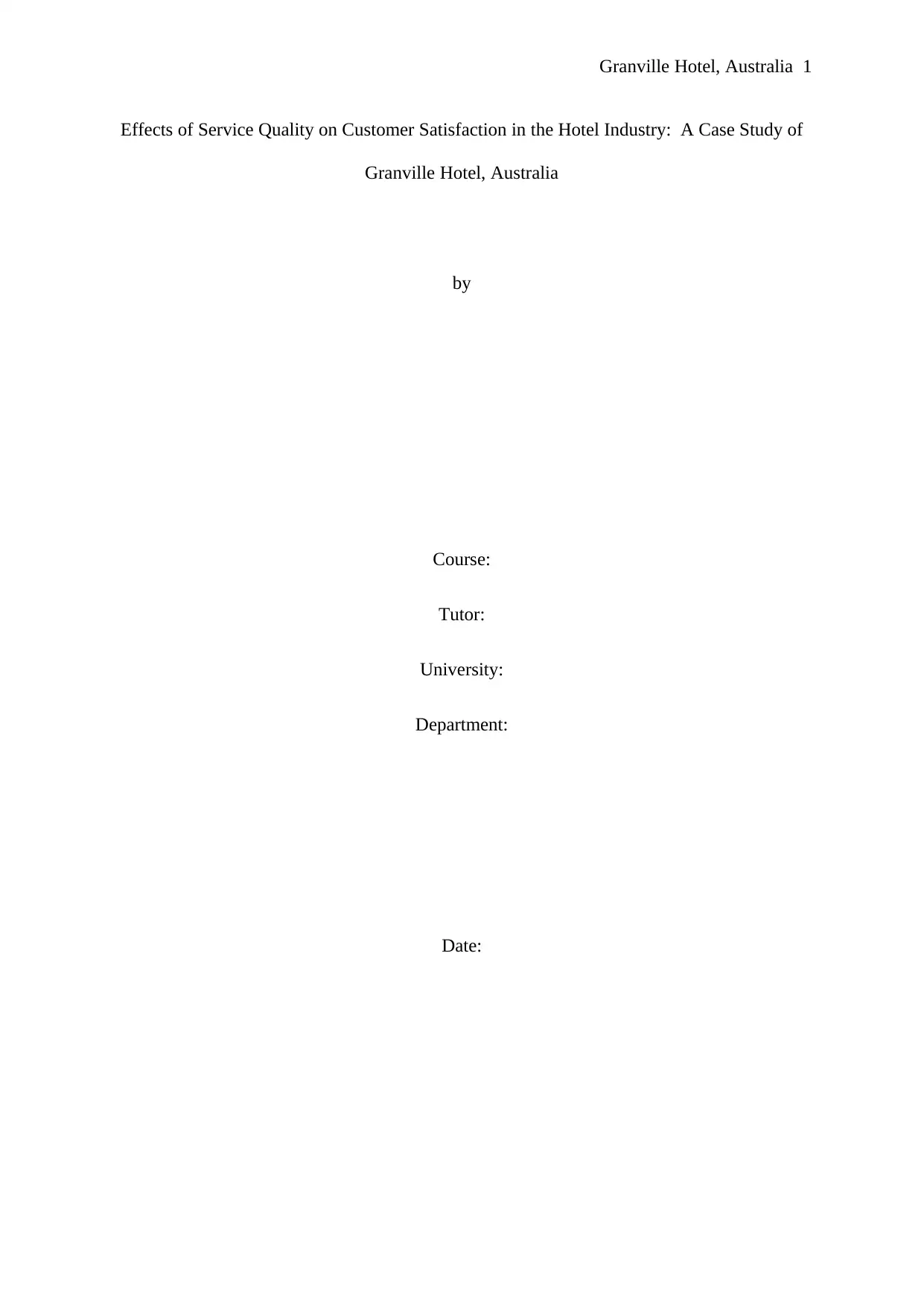
Granville Hotel, Australia 1
Effects of Service Quality on Customer Satisfaction in the Hotel Industry: A Case Study of
Granville Hotel, Australia
by
Course:
Tutor:
University:
Department:
Date:
Effects of Service Quality on Customer Satisfaction in the Hotel Industry: A Case Study of
Granville Hotel, Australia
by
Course:
Tutor:
University:
Department:
Date:
Paraphrase This Document
Need a fresh take? Get an instant paraphrase of this document with our AI Paraphraser

Granville Hotel, Australia 2
Table of Contents
CHAPTER ONE: INTRODUCTION........................................................................................3
1.1 Background Information..................................................................................................3
1.2 Problem Definition...........................................................................................................3
CHAPTER TWO: LITERATURE REVIEW............................................................................5
2.1 Introduction......................................................................................................................5
2.2 Service Quality.................................................................................................................5
2.3 Determinants of Service Quality......................................................................................5
2.4 Measurements of Service Quality....................................................................................6
2.4.1The SERVIQUAL Model...........................................................................................6
2.5 Customer Satisfaction.......................................................................................................6
2.6 Factors Affecting Customer Satisfaction..........................................................................7
2.7 Relationship between Service Quality and Customer Satisfaction..................................7
2.8 Conceptual Framework....................................................................................................7
CHAPTER THREE: RESEARCH METHODOLOGY.............................................................8
3.1 Introduction......................................................................................................................8
3.2 Research Design and Justification....................................................................................8
3.3 Data Sources.....................................................................................................................8
3.4 Conceptualization and Measurement...............................................................................9
3.5 Data Collection...............................................................................................................10
3.6 Data Analysis..................................................................................................................10
CHAPTER FOUR: ETHICAL ISSUES AND LIMITATIONS IN RESEARCH...................12
4.1 Ethical Research Issues..................................................................................................12
4.2 Study Limitations...........................................................................................................12
CHAPTER FIVE: PROPOSED BUDGET AND TIME-FRAME..........................................13
5.1 Proposed Budget.............................................................................................................13
5.2 Proposed Time-frame.....................................................................................................13
References................................................................................................................................15
Appendices...............................................................................................................................16
Appendix 1: Questionnaire...................................................................................................16
Table of Contents
CHAPTER ONE: INTRODUCTION........................................................................................3
1.1 Background Information..................................................................................................3
1.2 Problem Definition...........................................................................................................3
CHAPTER TWO: LITERATURE REVIEW............................................................................5
2.1 Introduction......................................................................................................................5
2.2 Service Quality.................................................................................................................5
2.3 Determinants of Service Quality......................................................................................5
2.4 Measurements of Service Quality....................................................................................6
2.4.1The SERVIQUAL Model...........................................................................................6
2.5 Customer Satisfaction.......................................................................................................6
2.6 Factors Affecting Customer Satisfaction..........................................................................7
2.7 Relationship between Service Quality and Customer Satisfaction..................................7
2.8 Conceptual Framework....................................................................................................7
CHAPTER THREE: RESEARCH METHODOLOGY.............................................................8
3.1 Introduction......................................................................................................................8
3.2 Research Design and Justification....................................................................................8
3.3 Data Sources.....................................................................................................................8
3.4 Conceptualization and Measurement...............................................................................9
3.5 Data Collection...............................................................................................................10
3.6 Data Analysis..................................................................................................................10
CHAPTER FOUR: ETHICAL ISSUES AND LIMITATIONS IN RESEARCH...................12
4.1 Ethical Research Issues..................................................................................................12
4.2 Study Limitations...........................................................................................................12
CHAPTER FIVE: PROPOSED BUDGET AND TIME-FRAME..........................................13
5.1 Proposed Budget.............................................................................................................13
5.2 Proposed Time-frame.....................................................................................................13
References................................................................................................................................15
Appendices...............................................................................................................................16
Appendix 1: Questionnaire...................................................................................................16
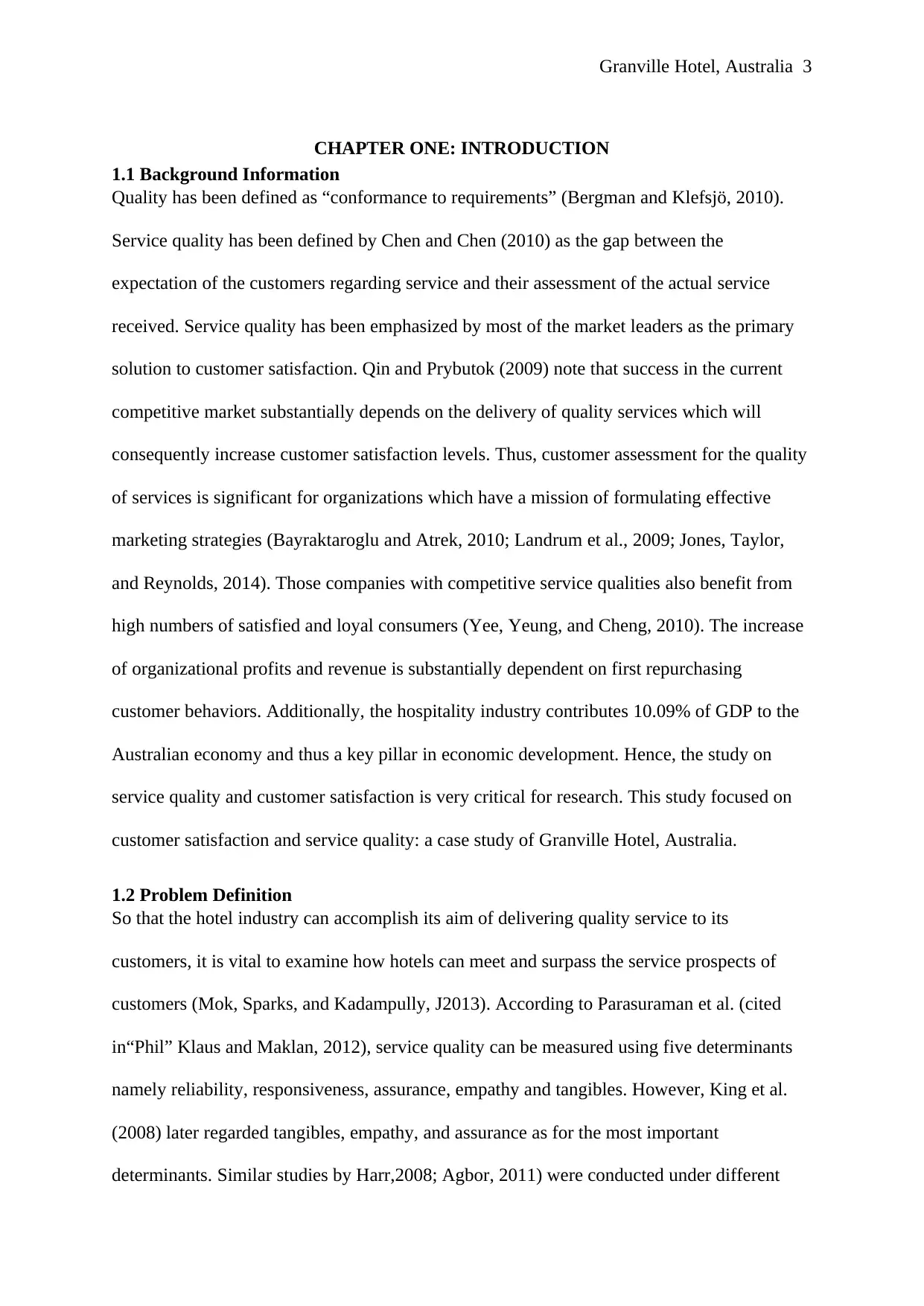
Granville Hotel, Australia 3
CHAPTER ONE: INTRODUCTION
1.1 Background Information
Quality has been defined as “conformance to requirements” (Bergman and Klefsjö, 2010).
Service quality has been defined by Chen and Chen (2010) as the gap between the
expectation of the customers regarding service and their assessment of the actual service
received. Service quality has been emphasized by most of the market leaders as the primary
solution to customer satisfaction. Qin and Prybutok (2009) note that success in the current
competitive market substantially depends on the delivery of quality services which will
consequently increase customer satisfaction levels. Thus, customer assessment for the quality
of services is significant for organizations which have a mission of formulating effective
marketing strategies (Bayraktaroglu and Atrek, 2010; Landrum et al., 2009; Jones, Taylor,
and Reynolds, 2014). Those companies with competitive service qualities also benefit from
high numbers of satisfied and loyal consumers (Yee, Yeung, and Cheng, 2010). The increase
of organizational profits and revenue is substantially dependent on first repurchasing
customer behaviors. Additionally, the hospitality industry contributes 10.09% of GDP to the
Australian economy and thus a key pillar in economic development. Hence, the study on
service quality and customer satisfaction is very critical for research. This study focused on
customer satisfaction and service quality: a case study of Granville Hotel, Australia.
1.2 Problem Definition
So that the hotel industry can accomplish its aim of delivering quality service to its
customers, it is vital to examine how hotels can meet and surpass the service prospects of
customers (Mok, Sparks, and Kadampully, J2013). According to Parasuraman et al. (cited
in“Phil” Klaus and Maklan, 2012), service quality can be measured using five determinants
namely reliability, responsiveness, assurance, empathy and tangibles. However, King et al.
(2008) later regarded tangibles, empathy, and assurance as for the most important
determinants. Similar studies by Harr,2008; Agbor, 2011) were conducted under different
CHAPTER ONE: INTRODUCTION
1.1 Background Information
Quality has been defined as “conformance to requirements” (Bergman and Klefsjö, 2010).
Service quality has been defined by Chen and Chen (2010) as the gap between the
expectation of the customers regarding service and their assessment of the actual service
received. Service quality has been emphasized by most of the market leaders as the primary
solution to customer satisfaction. Qin and Prybutok (2009) note that success in the current
competitive market substantially depends on the delivery of quality services which will
consequently increase customer satisfaction levels. Thus, customer assessment for the quality
of services is significant for organizations which have a mission of formulating effective
marketing strategies (Bayraktaroglu and Atrek, 2010; Landrum et al., 2009; Jones, Taylor,
and Reynolds, 2014). Those companies with competitive service qualities also benefit from
high numbers of satisfied and loyal consumers (Yee, Yeung, and Cheng, 2010). The increase
of organizational profits and revenue is substantially dependent on first repurchasing
customer behaviors. Additionally, the hospitality industry contributes 10.09% of GDP to the
Australian economy and thus a key pillar in economic development. Hence, the study on
service quality and customer satisfaction is very critical for research. This study focused on
customer satisfaction and service quality: a case study of Granville Hotel, Australia.
1.2 Problem Definition
So that the hotel industry can accomplish its aim of delivering quality service to its
customers, it is vital to examine how hotels can meet and surpass the service prospects of
customers (Mok, Sparks, and Kadampully, J2013). According to Parasuraman et al. (cited
in“Phil” Klaus and Maklan, 2012), service quality can be measured using five determinants
namely reliability, responsiveness, assurance, empathy and tangibles. However, King et al.
(2008) later regarded tangibles, empathy, and assurance as for the most important
determinants. Similar studies by Harr,2008; Agbor, 2011) were conducted under different
⊘ This is a preview!⊘
Do you want full access?
Subscribe today to unlock all pages.

Trusted by 1+ million students worldwide
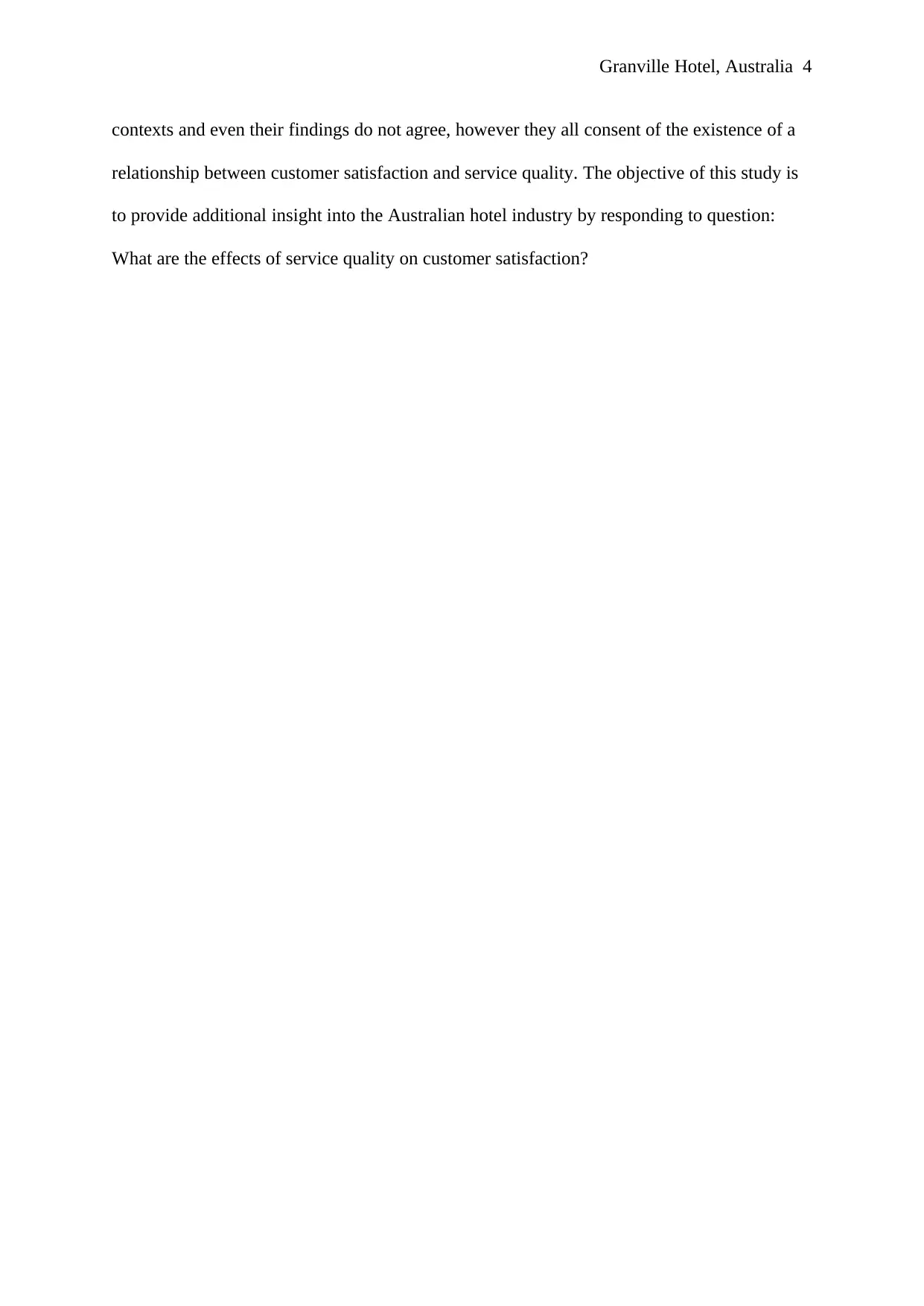
Granville Hotel, Australia 4
contexts and even their findings do not agree, however they all consent of the existence of a
relationship between customer satisfaction and service quality. The objective of this study is
to provide additional insight into the Australian hotel industry by responding to question:
What are the effects of service quality on customer satisfaction?
contexts and even their findings do not agree, however they all consent of the existence of a
relationship between customer satisfaction and service quality. The objective of this study is
to provide additional insight into the Australian hotel industry by responding to question:
What are the effects of service quality on customer satisfaction?
Paraphrase This Document
Need a fresh take? Get an instant paraphrase of this document with our AI Paraphraser
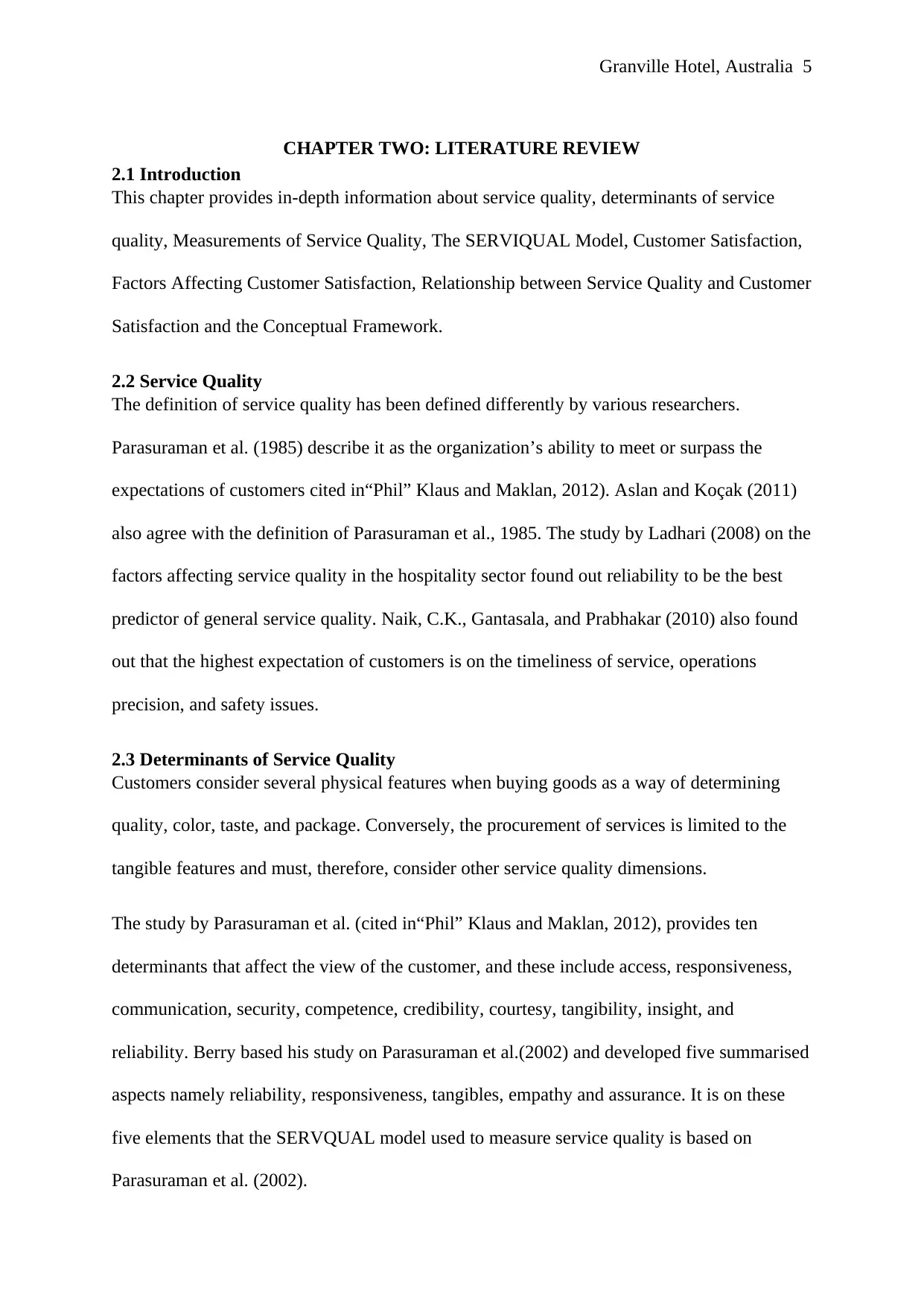
Granville Hotel, Australia 5
CHAPTER TWO: LITERATURE REVIEW
2.1 Introduction
This chapter provides in-depth information about service quality, determinants of service
quality, Measurements of Service Quality, The SERVIQUAL Model, Customer Satisfaction,
Factors Affecting Customer Satisfaction, Relationship between Service Quality and Customer
Satisfaction and the Conceptual Framework.
2.2 Service Quality
The definition of service quality has been defined differently by various researchers.
Parasuraman et al. (1985) describe it as the organization’s ability to meet or surpass the
expectations of customers cited in“Phil” Klaus and Maklan, 2012). Aslan and Koçak (2011)
also agree with the definition of Parasuraman et al., 1985. The study by Ladhari (2008) on the
factors affecting service quality in the hospitality sector found out reliability to be the best
predictor of general service quality. Naik, C.K., Gantasala, and Prabhakar (2010) also found
out that the highest expectation of customers is on the timeliness of service, operations
precision, and safety issues.
2.3 Determinants of Service Quality
Customers consider several physical features when buying goods as a way of determining
quality, color, taste, and package. Conversely, the procurement of services is limited to the
tangible features and must, therefore, consider other service quality dimensions.
The study by Parasuraman et al. (cited in“Phil” Klaus and Maklan, 2012), provides ten
determinants that affect the view of the customer, and these include access, responsiveness,
communication, security, competence, credibility, courtesy, tangibility, insight, and
reliability. Berry based his study on Parasuraman et al.(2002) and developed five summarised
aspects namely reliability, responsiveness, tangibles, empathy and assurance. It is on these
five elements that the SERVQUAL model used to measure service quality is based on
Parasuraman et al. (2002).
CHAPTER TWO: LITERATURE REVIEW
2.1 Introduction
This chapter provides in-depth information about service quality, determinants of service
quality, Measurements of Service Quality, The SERVIQUAL Model, Customer Satisfaction,
Factors Affecting Customer Satisfaction, Relationship between Service Quality and Customer
Satisfaction and the Conceptual Framework.
2.2 Service Quality
The definition of service quality has been defined differently by various researchers.
Parasuraman et al. (1985) describe it as the organization’s ability to meet or surpass the
expectations of customers cited in“Phil” Klaus and Maklan, 2012). Aslan and Koçak (2011)
also agree with the definition of Parasuraman et al., 1985. The study by Ladhari (2008) on the
factors affecting service quality in the hospitality sector found out reliability to be the best
predictor of general service quality. Naik, C.K., Gantasala, and Prabhakar (2010) also found
out that the highest expectation of customers is on the timeliness of service, operations
precision, and safety issues.
2.3 Determinants of Service Quality
Customers consider several physical features when buying goods as a way of determining
quality, color, taste, and package. Conversely, the procurement of services is limited to the
tangible features and must, therefore, consider other service quality dimensions.
The study by Parasuraman et al. (cited in“Phil” Klaus and Maklan, 2012), provides ten
determinants that affect the view of the customer, and these include access, responsiveness,
communication, security, competence, credibility, courtesy, tangibility, insight, and
reliability. Berry based his study on Parasuraman et al.(2002) and developed five summarised
aspects namely reliability, responsiveness, tangibles, empathy and assurance. It is on these
five elements that the SERVQUAL model used to measure service quality is based on
Parasuraman et al. (2002).
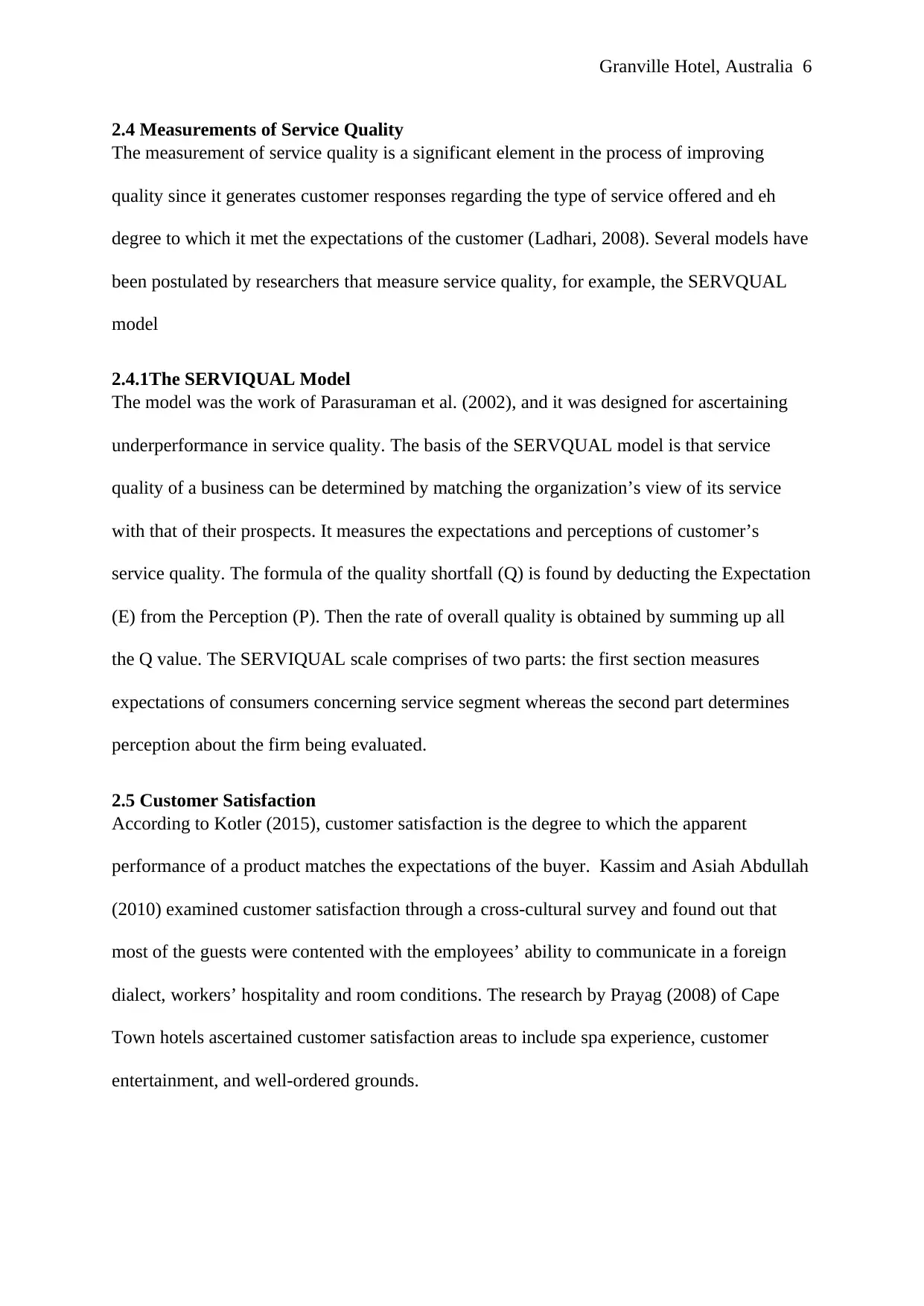
Granville Hotel, Australia 6
2.4 Measurements of Service Quality
The measurement of service quality is a significant element in the process of improving
quality since it generates customer responses regarding the type of service offered and eh
degree to which it met the expectations of the customer (Ladhari, 2008). Several models have
been postulated by researchers that measure service quality, for example, the SERVQUAL
model
2.4.1The SERVIQUAL Model
The model was the work of Parasuraman et al. (2002), and it was designed for ascertaining
underperformance in service quality. The basis of the SERVQUAL model is that service
quality of a business can be determined by matching the organization’s view of its service
with that of their prospects. It measures the expectations and perceptions of customer’s
service quality. The formula of the quality shortfall (Q) is found by deducting the Expectation
(E) from the Perception (P). Then the rate of overall quality is obtained by summing up all
the Q value. The SERVIQUAL scale comprises of two parts: the first section measures
expectations of consumers concerning service segment whereas the second part determines
perception about the firm being evaluated.
2.5 Customer Satisfaction
According to Kotler (2015), customer satisfaction is the degree to which the apparent
performance of a product matches the expectations of the buyer. Kassim and Asiah Abdullah
(2010) examined customer satisfaction through a cross-cultural survey and found out that
most of the guests were contented with the employees’ ability to communicate in a foreign
dialect, workers’ hospitality and room conditions. The research by Prayag (2008) of Cape
Town hotels ascertained customer satisfaction areas to include spa experience, customer
entertainment, and well-ordered grounds.
2.4 Measurements of Service Quality
The measurement of service quality is a significant element in the process of improving
quality since it generates customer responses regarding the type of service offered and eh
degree to which it met the expectations of the customer (Ladhari, 2008). Several models have
been postulated by researchers that measure service quality, for example, the SERVQUAL
model
2.4.1The SERVIQUAL Model
The model was the work of Parasuraman et al. (2002), and it was designed for ascertaining
underperformance in service quality. The basis of the SERVQUAL model is that service
quality of a business can be determined by matching the organization’s view of its service
with that of their prospects. It measures the expectations and perceptions of customer’s
service quality. The formula of the quality shortfall (Q) is found by deducting the Expectation
(E) from the Perception (P). Then the rate of overall quality is obtained by summing up all
the Q value. The SERVIQUAL scale comprises of two parts: the first section measures
expectations of consumers concerning service segment whereas the second part determines
perception about the firm being evaluated.
2.5 Customer Satisfaction
According to Kotler (2015), customer satisfaction is the degree to which the apparent
performance of a product matches the expectations of the buyer. Kassim and Asiah Abdullah
(2010) examined customer satisfaction through a cross-cultural survey and found out that
most of the guests were contented with the employees’ ability to communicate in a foreign
dialect, workers’ hospitality and room conditions. The research by Prayag (2008) of Cape
Town hotels ascertained customer satisfaction areas to include spa experience, customer
entertainment, and well-ordered grounds.
⊘ This is a preview!⊘
Do you want full access?
Subscribe today to unlock all pages.

Trusted by 1+ million students worldwide
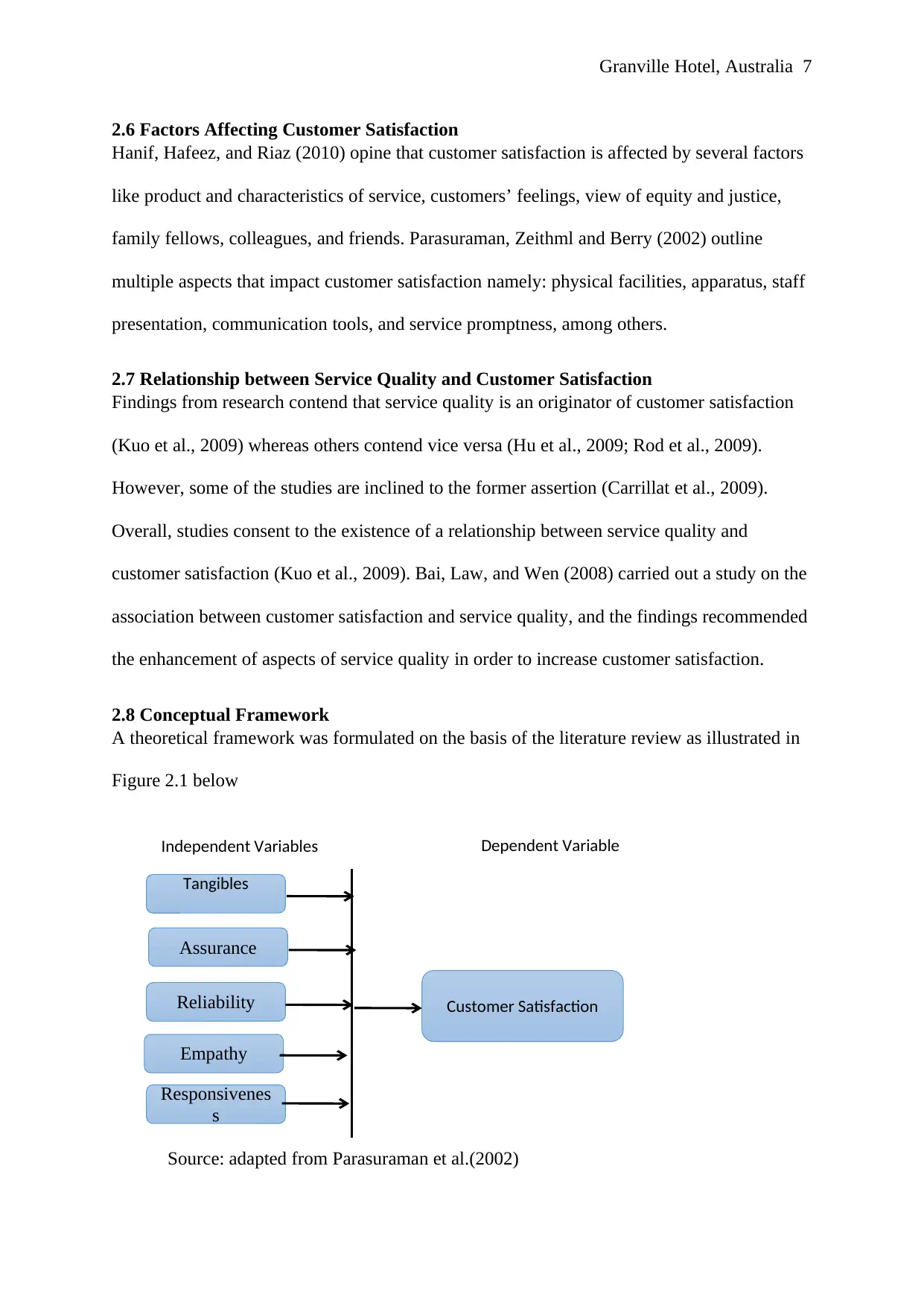
Granville Hotel, Australia 7
2.6 Factors Affecting Customer Satisfaction
Hanif, Hafeez, and Riaz (2010) opine that customer satisfaction is affected by several factors
like product and characteristics of service, customers’ feelings, view of equity and justice,
family fellows, colleagues, and friends. Parasuraman, Zeithml and Berry (2002) outline
multiple aspects that impact customer satisfaction namely: physical facilities, apparatus, staff
presentation, communication tools, and service promptness, among others.
2.7 Relationship between Service Quality and Customer Satisfaction
Findings from research contend that service quality is an originator of customer satisfaction
(Kuo et al., 2009) whereas others contend vice versa (Hu et al., 2009; Rod et al., 2009).
However, some of the studies are inclined to the former assertion (Carrillat et al., 2009).
Overall, studies consent to the existence of a relationship between service quality and
customer satisfaction (Kuo et al., 2009). Bai, Law, and Wen (2008) carried out a study on the
association between customer satisfaction and service quality, and the findings recommended
the enhancement of aspects of service quality in order to increase customer satisfaction.
2.8 Conceptual Framework
A theoretical framework was formulated on the basis of the literature review as illustrated in
Figure 2.1 below
Source: adapted from Parasuraman et al.(2002)
Assurance
Reliability
Empathy
Responsivenes
s
Tangibles
Customer Satisfaction
Independent Variables Dependent Variable
2.6 Factors Affecting Customer Satisfaction
Hanif, Hafeez, and Riaz (2010) opine that customer satisfaction is affected by several factors
like product and characteristics of service, customers’ feelings, view of equity and justice,
family fellows, colleagues, and friends. Parasuraman, Zeithml and Berry (2002) outline
multiple aspects that impact customer satisfaction namely: physical facilities, apparatus, staff
presentation, communication tools, and service promptness, among others.
2.7 Relationship between Service Quality and Customer Satisfaction
Findings from research contend that service quality is an originator of customer satisfaction
(Kuo et al., 2009) whereas others contend vice versa (Hu et al., 2009; Rod et al., 2009).
However, some of the studies are inclined to the former assertion (Carrillat et al., 2009).
Overall, studies consent to the existence of a relationship between service quality and
customer satisfaction (Kuo et al., 2009). Bai, Law, and Wen (2008) carried out a study on the
association between customer satisfaction and service quality, and the findings recommended
the enhancement of aspects of service quality in order to increase customer satisfaction.
2.8 Conceptual Framework
A theoretical framework was formulated on the basis of the literature review as illustrated in
Figure 2.1 below
Source: adapted from Parasuraman et al.(2002)
Assurance
Reliability
Empathy
Responsivenes
s
Tangibles
Customer Satisfaction
Independent Variables Dependent Variable
Paraphrase This Document
Need a fresh take? Get an instant paraphrase of this document with our AI Paraphraser
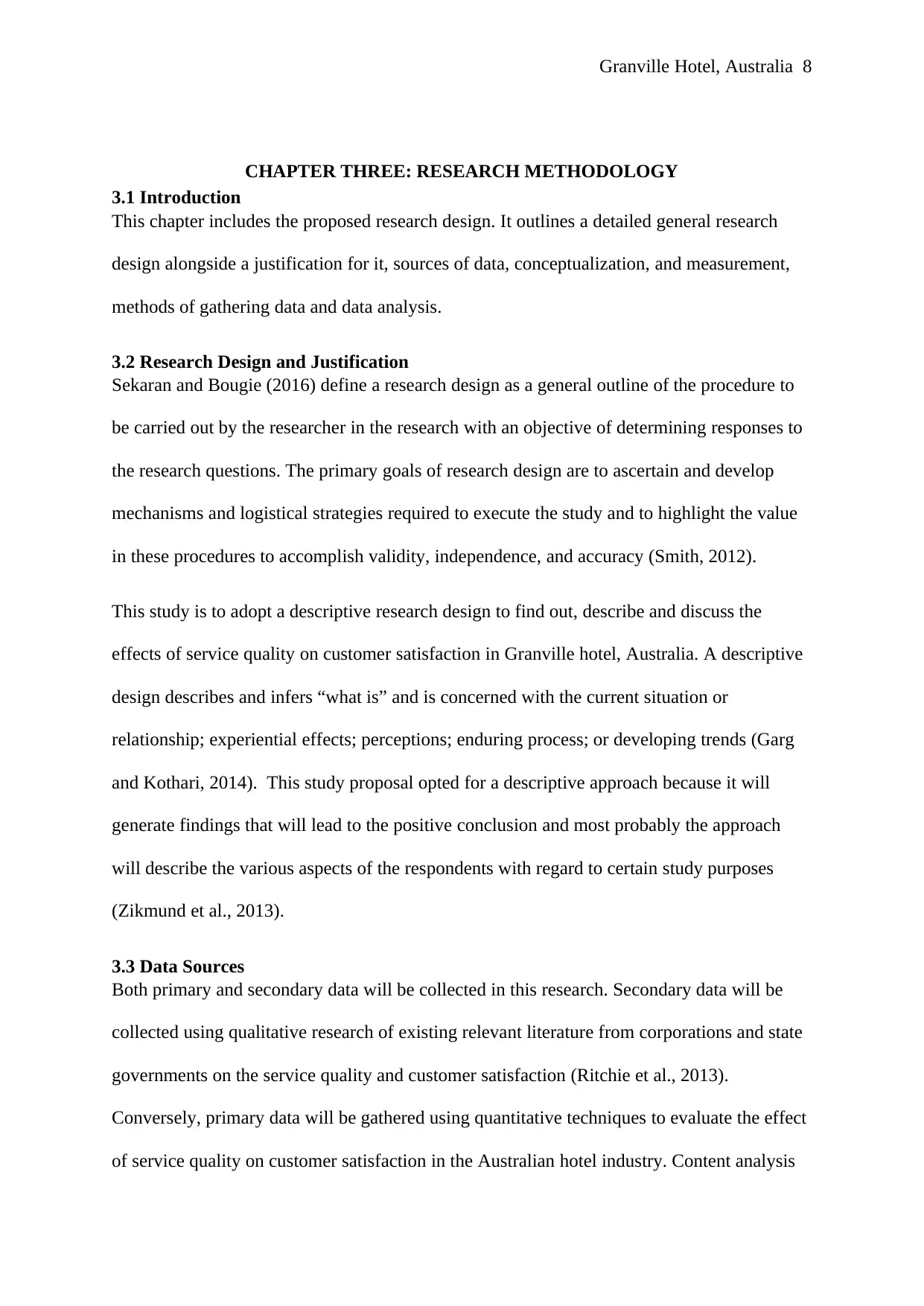
Granville Hotel, Australia 8
CHAPTER THREE: RESEARCH METHODOLOGY
3.1 Introduction
This chapter includes the proposed research design. It outlines a detailed general research
design alongside a justification for it, sources of data, conceptualization, and measurement,
methods of gathering data and data analysis.
3.2 Research Design and Justification
Sekaran and Bougie (2016) define a research design as a general outline of the procedure to
be carried out by the researcher in the research with an objective of determining responses to
the research questions. The primary goals of research design are to ascertain and develop
mechanisms and logistical strategies required to execute the study and to highlight the value
in these procedures to accomplish validity, independence, and accuracy (Smith, 2012).
This study is to adopt a descriptive research design to find out, describe and discuss the
effects of service quality on customer satisfaction in Granville hotel, Australia. A descriptive
design describes and infers “what is” and is concerned with the current situation or
relationship; experiential effects; perceptions; enduring process; or developing trends (Garg
and Kothari, 2014). This study proposal opted for a descriptive approach because it will
generate findings that will lead to the positive conclusion and most probably the approach
will describe the various aspects of the respondents with regard to certain study purposes
(Zikmund et al., 2013).
3.3 Data Sources
Both primary and secondary data will be collected in this research. Secondary data will be
collected using qualitative research of existing relevant literature from corporations and state
governments on the service quality and customer satisfaction (Ritchie et al., 2013).
Conversely, primary data will be gathered using quantitative techniques to evaluate the effect
of service quality on customer satisfaction in the Australian hotel industry. Content analysis
CHAPTER THREE: RESEARCH METHODOLOGY
3.1 Introduction
This chapter includes the proposed research design. It outlines a detailed general research
design alongside a justification for it, sources of data, conceptualization, and measurement,
methods of gathering data and data analysis.
3.2 Research Design and Justification
Sekaran and Bougie (2016) define a research design as a general outline of the procedure to
be carried out by the researcher in the research with an objective of determining responses to
the research questions. The primary goals of research design are to ascertain and develop
mechanisms and logistical strategies required to execute the study and to highlight the value
in these procedures to accomplish validity, independence, and accuracy (Smith, 2012).
This study is to adopt a descriptive research design to find out, describe and discuss the
effects of service quality on customer satisfaction in Granville hotel, Australia. A descriptive
design describes and infers “what is” and is concerned with the current situation or
relationship; experiential effects; perceptions; enduring process; or developing trends (Garg
and Kothari, 2014). This study proposal opted for a descriptive approach because it will
generate findings that will lead to the positive conclusion and most probably the approach
will describe the various aspects of the respondents with regard to certain study purposes
(Zikmund et al., 2013).
3.3 Data Sources
Both primary and secondary data will be collected in this research. Secondary data will be
collected using qualitative research of existing relevant literature from corporations and state
governments on the service quality and customer satisfaction (Ritchie et al., 2013).
Conversely, primary data will be gathered using quantitative techniques to evaluate the effect
of service quality on customer satisfaction in the Australian hotel industry. Content analysis
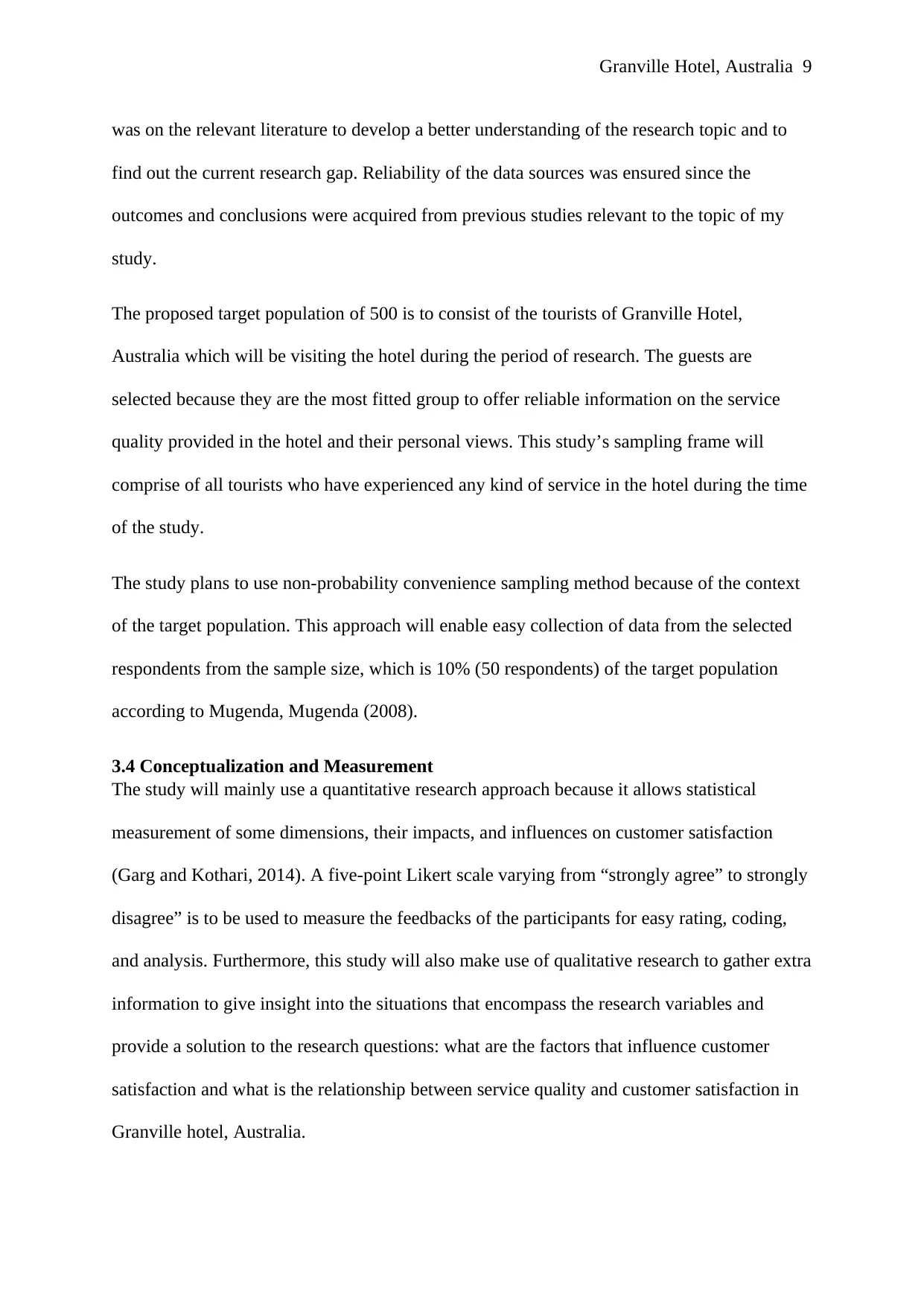
Granville Hotel, Australia 9
was on the relevant literature to develop a better understanding of the research topic and to
find out the current research gap. Reliability of the data sources was ensured since the
outcomes and conclusions were acquired from previous studies relevant to the topic of my
study.
The proposed target population of 500 is to consist of the tourists of Granville Hotel,
Australia which will be visiting the hotel during the period of research. The guests are
selected because they are the most fitted group to offer reliable information on the service
quality provided in the hotel and their personal views. This study’s sampling frame will
comprise of all tourists who have experienced any kind of service in the hotel during the time
of the study.
The study plans to use non-probability convenience sampling method because of the context
of the target population. This approach will enable easy collection of data from the selected
respondents from the sample size, which is 10% (50 respondents) of the target population
according to Mugenda, Mugenda (2008).
3.4 Conceptualization and Measurement
The study will mainly use a quantitative research approach because it allows statistical
measurement of some dimensions, their impacts, and influences on customer satisfaction
(Garg and Kothari, 2014). A five-point Likert scale varying from “strongly agree” to strongly
disagree” is to be used to measure the feedbacks of the participants for easy rating, coding,
and analysis. Furthermore, this study will also make use of qualitative research to gather extra
information to give insight into the situations that encompass the research variables and
provide a solution to the research questions: what are the factors that influence customer
satisfaction and what is the relationship between service quality and customer satisfaction in
Granville hotel, Australia.
was on the relevant literature to develop a better understanding of the research topic and to
find out the current research gap. Reliability of the data sources was ensured since the
outcomes and conclusions were acquired from previous studies relevant to the topic of my
study.
The proposed target population of 500 is to consist of the tourists of Granville Hotel,
Australia which will be visiting the hotel during the period of research. The guests are
selected because they are the most fitted group to offer reliable information on the service
quality provided in the hotel and their personal views. This study’s sampling frame will
comprise of all tourists who have experienced any kind of service in the hotel during the time
of the study.
The study plans to use non-probability convenience sampling method because of the context
of the target population. This approach will enable easy collection of data from the selected
respondents from the sample size, which is 10% (50 respondents) of the target population
according to Mugenda, Mugenda (2008).
3.4 Conceptualization and Measurement
The study will mainly use a quantitative research approach because it allows statistical
measurement of some dimensions, their impacts, and influences on customer satisfaction
(Garg and Kothari, 2014). A five-point Likert scale varying from “strongly agree” to strongly
disagree” is to be used to measure the feedbacks of the participants for easy rating, coding,
and analysis. Furthermore, this study will also make use of qualitative research to gather extra
information to give insight into the situations that encompass the research variables and
provide a solution to the research questions: what are the factors that influence customer
satisfaction and what is the relationship between service quality and customer satisfaction in
Granville hotel, Australia.
⊘ This is a preview!⊘
Do you want full access?
Subscribe today to unlock all pages.

Trusted by 1+ million students worldwide

Granville Hotel, Australia 10
3.5 Data Collection
This study will use primary data which is to be gathered using a questionnaire with five
statements developed from the Landrum et al. (2009) as a modification of the SERVQUAL
model. The questionnaire is conveniently chosen by the researcher because it is more
accurate, convenient to use, preserves anonymity of respondents, and it’s cost-effective (Garg
and Kothari, 2014). Furthermore, the researcher intends to gather the attitudes, views, and
behaviors of the participants, hence a questionnaire best fits the research situation. The
questionnaire is customized to three sections. Section one consist of demographic features of
the respondents and this will assist in obtaining information on the type of guest. Section two
will measure the rate the indicated dimensions affect customer satisfaction. The third part will
measure the perception levels concerning the hotel services. The questionnaires will be
administered by the researcher to each subject of the sample and then picked later
3.6 Data Analysis
The research will use quantitative data analysis methods to analyze data namely descriptive
and inferential statistics since they are better in illustrating events occurrence by making
statistical relationships between the research variables (Sekaran and Bougie, 2016). The study
is to adopt the mean as the descriptive statistical method while correlations between the study
variables are to be determined under inferential statistics. Data analysis will be done using the
Statistical Package for the Social Sciences software (SPSS) version 22.
To determine the association between the study variables with customer satisfaction, a
multivariate regression model will be adopted as illustrated below.
Y = β0+ β1X1 + β2X2 + β3X3+ β4X4+ β5X5+ẹ
Where:
Y = customer satisfaction
3.5 Data Collection
This study will use primary data which is to be gathered using a questionnaire with five
statements developed from the Landrum et al. (2009) as a modification of the SERVQUAL
model. The questionnaire is conveniently chosen by the researcher because it is more
accurate, convenient to use, preserves anonymity of respondents, and it’s cost-effective (Garg
and Kothari, 2014). Furthermore, the researcher intends to gather the attitudes, views, and
behaviors of the participants, hence a questionnaire best fits the research situation. The
questionnaire is customized to three sections. Section one consist of demographic features of
the respondents and this will assist in obtaining information on the type of guest. Section two
will measure the rate the indicated dimensions affect customer satisfaction. The third part will
measure the perception levels concerning the hotel services. The questionnaires will be
administered by the researcher to each subject of the sample and then picked later
3.6 Data Analysis
The research will use quantitative data analysis methods to analyze data namely descriptive
and inferential statistics since they are better in illustrating events occurrence by making
statistical relationships between the research variables (Sekaran and Bougie, 2016). The study
is to adopt the mean as the descriptive statistical method while correlations between the study
variables are to be determined under inferential statistics. Data analysis will be done using the
Statistical Package for the Social Sciences software (SPSS) version 22.
To determine the association between the study variables with customer satisfaction, a
multivariate regression model will be adopted as illustrated below.
Y = β0+ β1X1 + β2X2 + β3X3+ β4X4+ β5X5+ẹ
Where:
Y = customer satisfaction
Paraphrase This Document
Need a fresh take? Get an instant paraphrase of this document with our AI Paraphraser
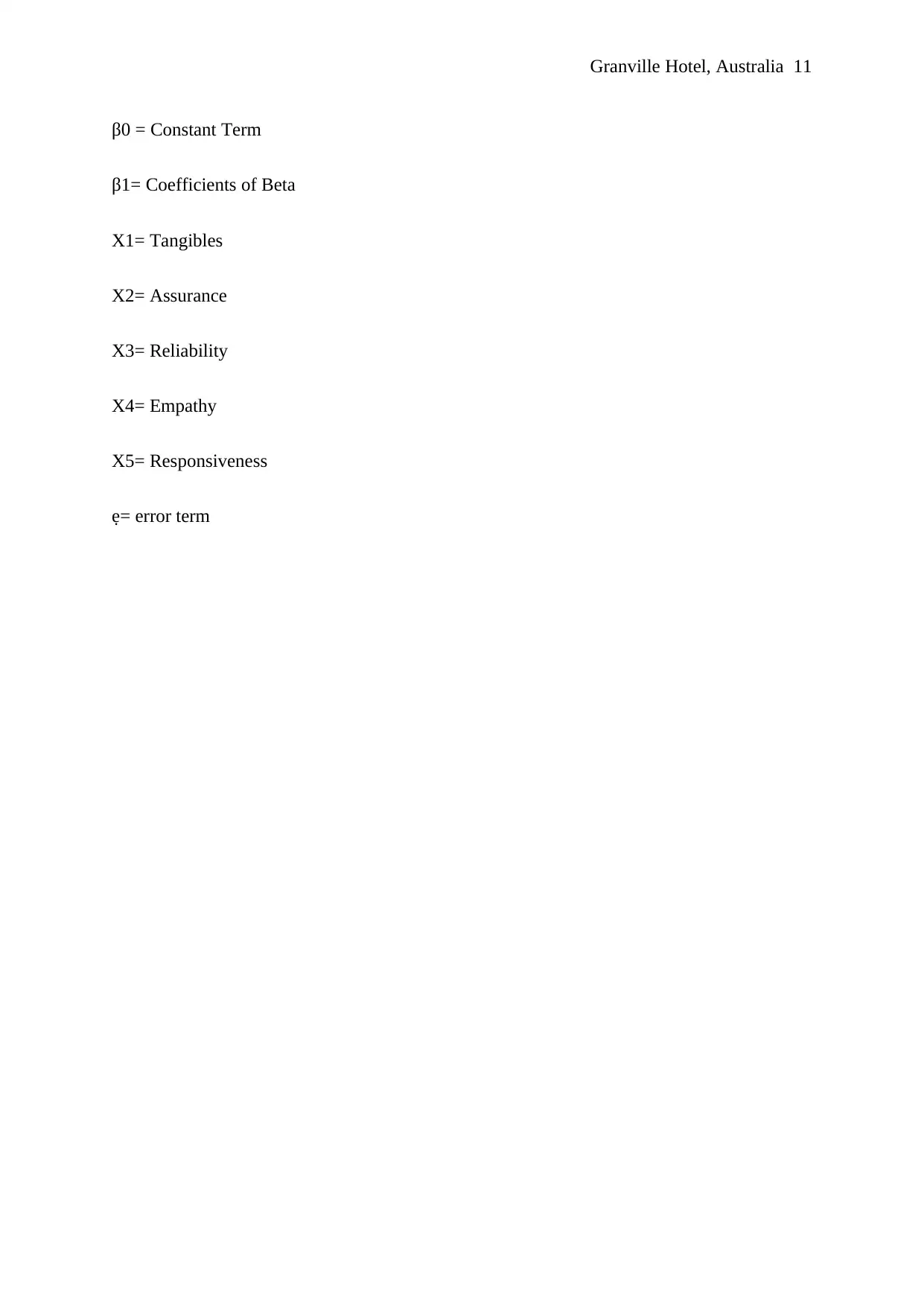
Granville Hotel, Australia 11
β0 = Constant Term
β1= Coefficients of Beta
X1= Tangibles
X2= Assurance
X3= Reliability
X4= Empathy
X5= Responsiveness
ẹ= error term
β0 = Constant Term
β1= Coefficients of Beta
X1= Tangibles
X2= Assurance
X3= Reliability
X4= Empathy
X5= Responsiveness
ẹ= error term

Granville Hotel, Australia 12
CHAPTER FOUR: ETHICAL ISSUES AND LIMITATIONS IN RESEARCH
4.1 Ethical Research Issues
The participants’ identities will be held in anonymity in the entire research to avoid any
possible harm to the individual participants. Furthermore, the information obtained from
Granville hotel, Australia will be treated with utmost confidentiality and used only for the
intentions initially outlined in the university’s introductory letter, and that is just for academic
purposes. Informed consent will also be sought from the potential participants before they are
engaged in the research. All relevant and important information will be made available to
them including the time frame of the study, assurance of discretion, confidentiality and the
aim of the research.
4.2 Study Limitations
The survey only covers the Granville hotel in Australia because of the limited budget and
allotted time which will not permit a bigger sample size through the incorporation of other
hotels in Australia. As a result, this study uses a rather small sample size which is likely to
limit the application of its outcomes to a larger scale. The research should have better
included other Hotels in Australia to make the sample size larger and enable generalization in
different geographical settings.
The prospective primary challenge of this study is a reluctance to participate in the study by
the respondents for fear of destroying the organization’s reputation and endangering the
career of the employees. Nevertheless, the research intends to address this issue by attaching
the introduction letter from the university with the questionnaire as a way of guaranteeing the
confidentiality of collected information and its intended objective.
CHAPTER FOUR: ETHICAL ISSUES AND LIMITATIONS IN RESEARCH
4.1 Ethical Research Issues
The participants’ identities will be held in anonymity in the entire research to avoid any
possible harm to the individual participants. Furthermore, the information obtained from
Granville hotel, Australia will be treated with utmost confidentiality and used only for the
intentions initially outlined in the university’s introductory letter, and that is just for academic
purposes. Informed consent will also be sought from the potential participants before they are
engaged in the research. All relevant and important information will be made available to
them including the time frame of the study, assurance of discretion, confidentiality and the
aim of the research.
4.2 Study Limitations
The survey only covers the Granville hotel in Australia because of the limited budget and
allotted time which will not permit a bigger sample size through the incorporation of other
hotels in Australia. As a result, this study uses a rather small sample size which is likely to
limit the application of its outcomes to a larger scale. The research should have better
included other Hotels in Australia to make the sample size larger and enable generalization in
different geographical settings.
The prospective primary challenge of this study is a reluctance to participate in the study by
the respondents for fear of destroying the organization’s reputation and endangering the
career of the employees. Nevertheless, the research intends to address this issue by attaching
the introduction letter from the university with the questionnaire as a way of guaranteeing the
confidentiality of collected information and its intended objective.
⊘ This is a preview!⊘
Do you want full access?
Subscribe today to unlock all pages.

Trusted by 1+ million students worldwide
1 out of 21
Related Documents
Your All-in-One AI-Powered Toolkit for Academic Success.
+13062052269
info@desklib.com
Available 24*7 on WhatsApp / Email
![[object Object]](/_next/static/media/star-bottom.7253800d.svg)
Unlock your academic potential
Copyright © 2020–2025 A2Z Services. All Rights Reserved. Developed and managed by ZUCOL.





